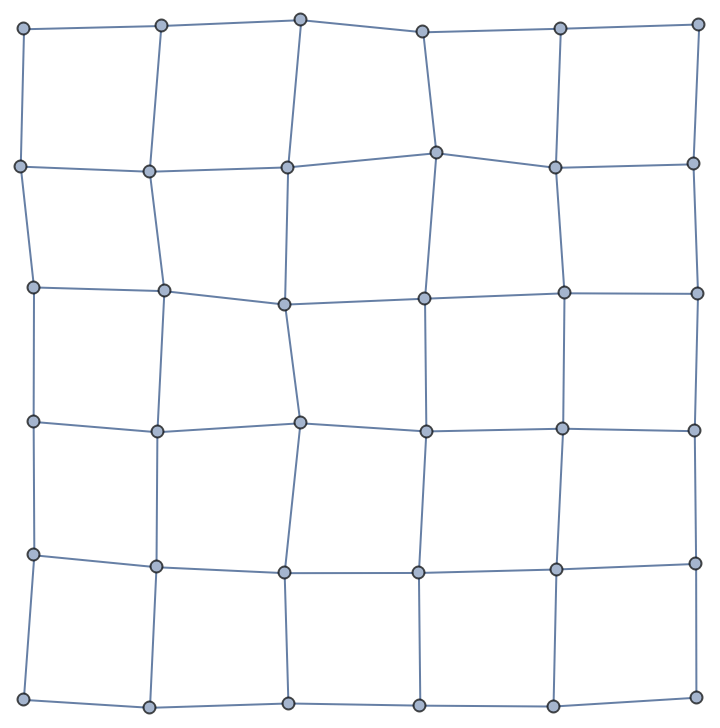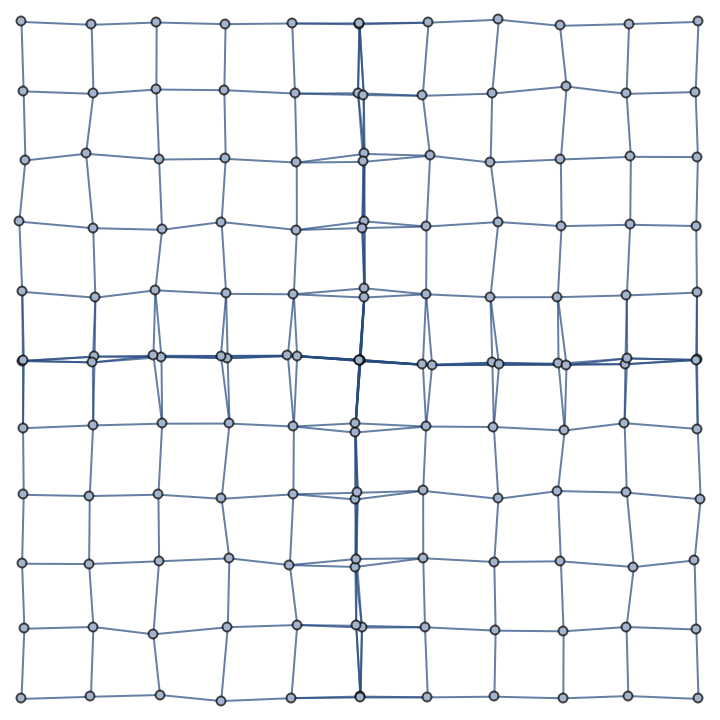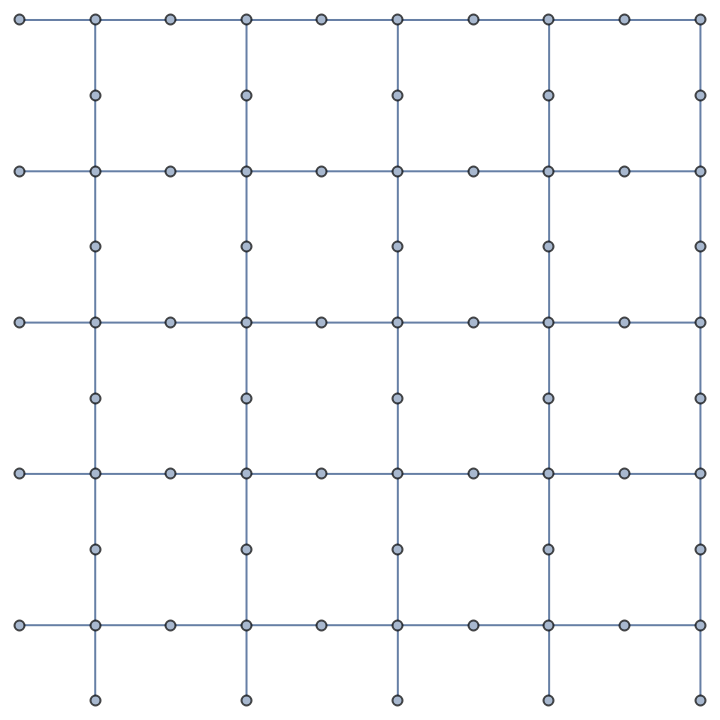Basic Examples (2)
Compute entropy for a nearest neighbor graph of 20 random points:
Build the nearest neighbor graph of a perfect square lattice with unit lattice constant:
Compute the graph entropy and verify it is equal to zero as expected by symmetry:
Scope (3)
Define a 2D set of point arranged in a square lattice, add distortions to have all edges unequal as in a 2D disordered system and build the corresponding NearestNeighborGraph with all nearest neighbor connections within a given radius:
Compute the graph entropy:
Check it is equal to the natural logarithm of the number of distinct edges in the graph:
Options (2)
Treat some distance values as equal if they differ by an optional threshold "MinThreshold" set to a given positive value. This introduces some order into the graph layout:
Check that graph entropy is lower than in the case without rounding factor:
Applications (2)
Build a linear graph mapped to the coordinates of a one-dimensional Fibonacci quasiperiodic chain with nit iterations and spacing ratio between nodes tau:
Computes its graph entropy:
Check that the numerical value of the graph entropy converges to the universal value 0.665:
This universal value 0.665 is also independent of the spacing ratio between graph nodes:
If a point symmetry element of order Cn is present in the graph, then the graph entropy is equal to ln(E/n) where E is the total number of edges in the graph and n is the order of the rotation symmetry.
Start from a slightly disordered square lattice and apply rotations of 0, π/2, π and -π/2 to the starting lattice points to get three additional sub-lattices:
Build the overall graph connecting all points belonging to the four sub-lattices:
Compute numerically the graph entropy for this system:
Check that it is close to the natural logarithm of the number of graph edges divided by the symmetry order:
Properties and Relations (2)
Define a grid of points:
As noise is added to the graph, the entropy increases:
Neat Examples (2)
Build a 2D graph mapped to the coordinates of a two-dimensional Fibonacci quasiperiodic array with nit iterations:
Check that the numerical value of the graph entropy still converges to the universal value 0.665 known from 1D case (computation takes a few seconds):
A semi-regular set of points obtained by alternatively deleting sites from a square lattice:
Check that the graph entropy is still zero as expected by symmetry:
![b = LatticeData["SquareLattice", "Basis"];
pts = Tuples[Range[0, 5], 2] . b](https://www.wolframcloud.com/obj/resourcesystem/images/903/90365bb1-968b-4918-821d-e1e26969e2ab/642649aafd10a8bc.png)

![SeedRandom[123];
b = LatticeData["SquareLattice", "Basis"]; pts = Tuples[Range[0, 5], 2] . b;
dissquarepts = pts + RandomReal[{-0.075, 0.075}, {Length[pts]}];
NearestNeighborGraph[dissquarepts, {All, 1.2}]](https://www.wolframcloud.com/obj/resourcesystem/images/903/90365bb1-968b-4918-821d-e1e26969e2ab/5a2094c609baaa31.png)

![SeedRandom[123];
dissquarepts = Tuples[Range[0, 5], 2] . LatticeData["SquareLattice", "Basis"] + RandomReal[{-0.075, 0.075}, {Length[pts]}];](https://www.wolframcloud.com/obj/resourcesystem/images/903/90365bb1-968b-4918-821d-e1e26969e2ab/148ee94884aa2b03.png)
![TrueQ[ResourceFunction["NearestNeighborGraphEntropy"][dissquarepts, 1.2, "MinThreshold" -> 0.01] < ResourceFunction["NearestNeighborGraphEntropy"][dissquarepts, 1.2]]](https://www.wolframcloud.com/obj/resourcesystem/images/903/90365bb1-968b-4918-821d-e1e26969e2ab/3b2b46c3c297e3e1.png)
![grfibo1d[nit_, tau_] := Module[{niter = nit (* number of iterations *),
Fibonaccirule, wordlist, coordlist, tauratio = tau (* ratio between edge lenghts *), ptsfibo1d},
Fibonaccirule = {S :> {L}, L :> {L, S}};(* two-
letter Fibonacci inflation-deflation substitution rule *)
(* generation of the Fibonacci word sequence *)
wordlist = Flatten[Nest[(# /. Fibonaccirule) &, S, niter]];
coordlist = Prepend[Accumulate[wordlist], 0];(* added origin *)
ptsfibo1d = Transpose[{coordlist /. {L -> tauratio, S -> 1}, ConstantArray[0, Length[coordlist]]}]]](https://www.wolframcloud.com/obj/resourcesystem/images/903/90365bb1-968b-4918-821d-e1e26969e2ab/7c5736710e089829.png)
![Show[{ListPlot[
Transpose[{Range[2, 10, 1], Table[ResourceFunction["NearestNeighborGraphEntropy"][
grfibo1d[i, 2], 2], {i, 2, 10, 1}]}], PlotRange -> {{0, 12}, {0, 1.2}}, Frame -> True, FrameLabel -> {"Iterations", "Graph Entropy"}, LabelStyle -> Directive[Black, 14]], Plot[0.665, {x, 0, 12}, PlotStyle -> Red]}]](https://www.wolframcloud.com/obj/resourcesystem/images/903/90365bb1-968b-4918-821d-e1e26969e2ab/37abf4a2cdfcc5e0.png)

![Show[{ListPlot[
Transpose[{Range[2, 10, 1], Table[ResourceFunction["NearestNeighborGraphEntropy"][
grfibo1d[10, t], t], {t, 2, 10, 1}]}], PlotRange -> {{0, 11}, {0, 1.2}}, Frame -> True, FrameLabel -> {"Spacing ratio", "Graph Entropy"}, LabelStyle -> Directive[Black, 14]], Plot[0.665, {x, 0, 11}, PlotStyle -> Green]}]](https://www.wolframcloud.com/obj/resourcesystem/images/903/90365bb1-968b-4918-821d-e1e26969e2ab/6df1c51888539a31.png)

![SeedRandom[123];
b = LatticeData["SquareLattice", "Basis"]; pts = Tuples[Range[0, 5], 2] . b;
(* starting lattice *)
dissquarepts = pts + RandomReal[{-0.075, 0.075}, {Length[pts]}];
(* apply rotations *)
t0 = RotationTransform[\[Pi], {0, 0}];
t1 = RotationTransform[\[Pi]/2, {0, 0}];
t2 = RotationTransform[-\[Pi]/2, {0, 0}];
rotpts0 = t0[dissquarepts];
rotpts1 = t1[dissquarepts];
rotpts2 = t2[dissquarepts];
(* merge all sublattices *)
allpts = Flatten[{dissquarepts, rotpts0, rotpts1, rotpts2}, 1];](https://www.wolframcloud.com/obj/resourcesystem/images/903/90365bb1-968b-4918-821d-e1e26969e2ab/2407006dfb310247.png)


![grfibo2d[nit_] := Module[{niter = nit (* number of iterations *),
Fibonaccirule, wordlist, coordlist, coordgridprod, ptsfibo2d},
Fibonaccirule = {S :> {L}, L :> {L, S}};(* two-
letter Fibonacci inflation-deflation substitution rule *)
(* generation of the Fibonacci word sequence *)
wordlist = Flatten[Nest[(# /. Fibonaccirule) &, S, niter]];
coordlist = Prepend[Accumulate[wordlist], 0];(* added origin *)
coordgridprod = Outer[{#1, #2} &, coordlist, coordlist]; (* grid product *)
ptsfibo2d = Flatten[coordgridprod /. {L -> 1.4, S -> 1}, 1]
]](https://www.wolframcloud.com/obj/resourcesystem/images/903/90365bb1-968b-4918-821d-e1e26969e2ab/28271f4fac32e2d8.png)

![Show[{ListPlot[
Transpose[{Range[2, 10, 1], Table[ResourceFunction["NearestNeighborGraphEntropy"][grfibo2d[i],
1.41], {i, 2, 10, 1}]}], PlotRange -> {{0, 12}, {0, 1.2}}, Frame -> True, FrameLabel -> {"Iterations", "Graph Entropy"}, LabelStyle -> Directive[Black, 14]], Plot[0.665, {x, 0, 12}, PlotStyle -> Red]}]](https://www.wolframcloud.com/obj/resourcesystem/images/903/90365bb1-968b-4918-821d-e1e26969e2ab/06483d6729f689c0.png)

![b = LatticeData["SquareLattice", "Basis"];
pts = Tuples[Range[0, 9], 2] . b;
newpts = Delete[pts, {{1}, {3}, {5}, {7}, {9}, {21}, {23}, {25}, {27}, {29}, {41}, {43}, {45}, {47}, {49}, {61}, {63}, {65}, {67}, {69}, {81}, {83}, {85}, {87}, {89}}];
Graphics[{PointSize[Medium], Red, Point@newpts}]](https://www.wolframcloud.com/obj/resourcesystem/images/903/90365bb1-968b-4918-821d-e1e26969e2ab/721832d5672a42be.png)

